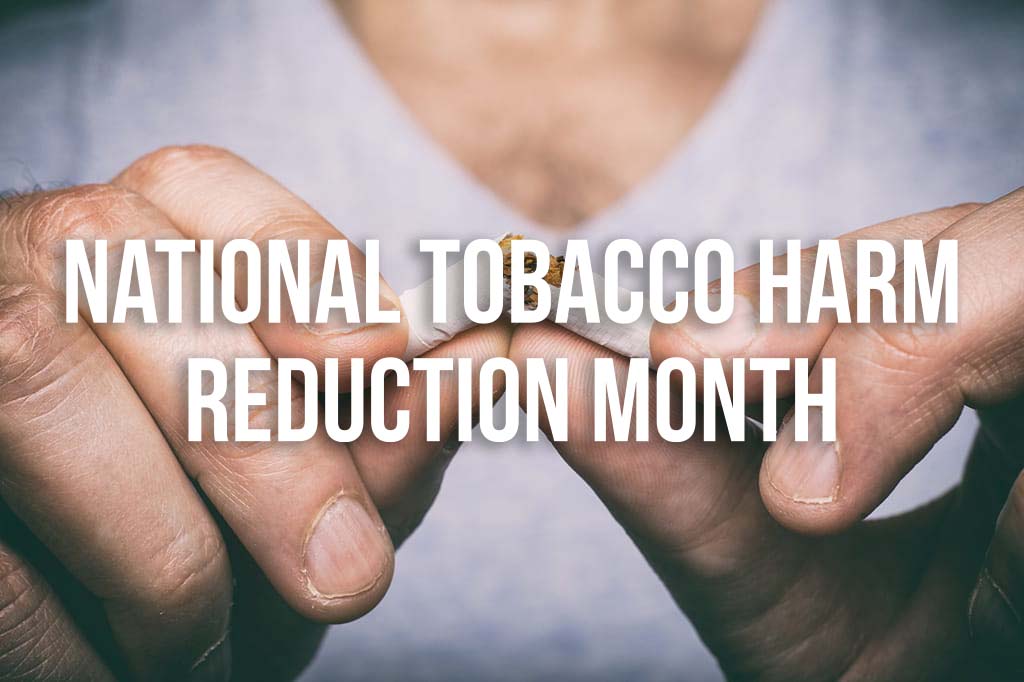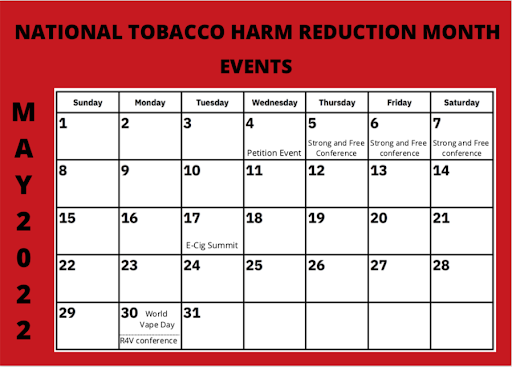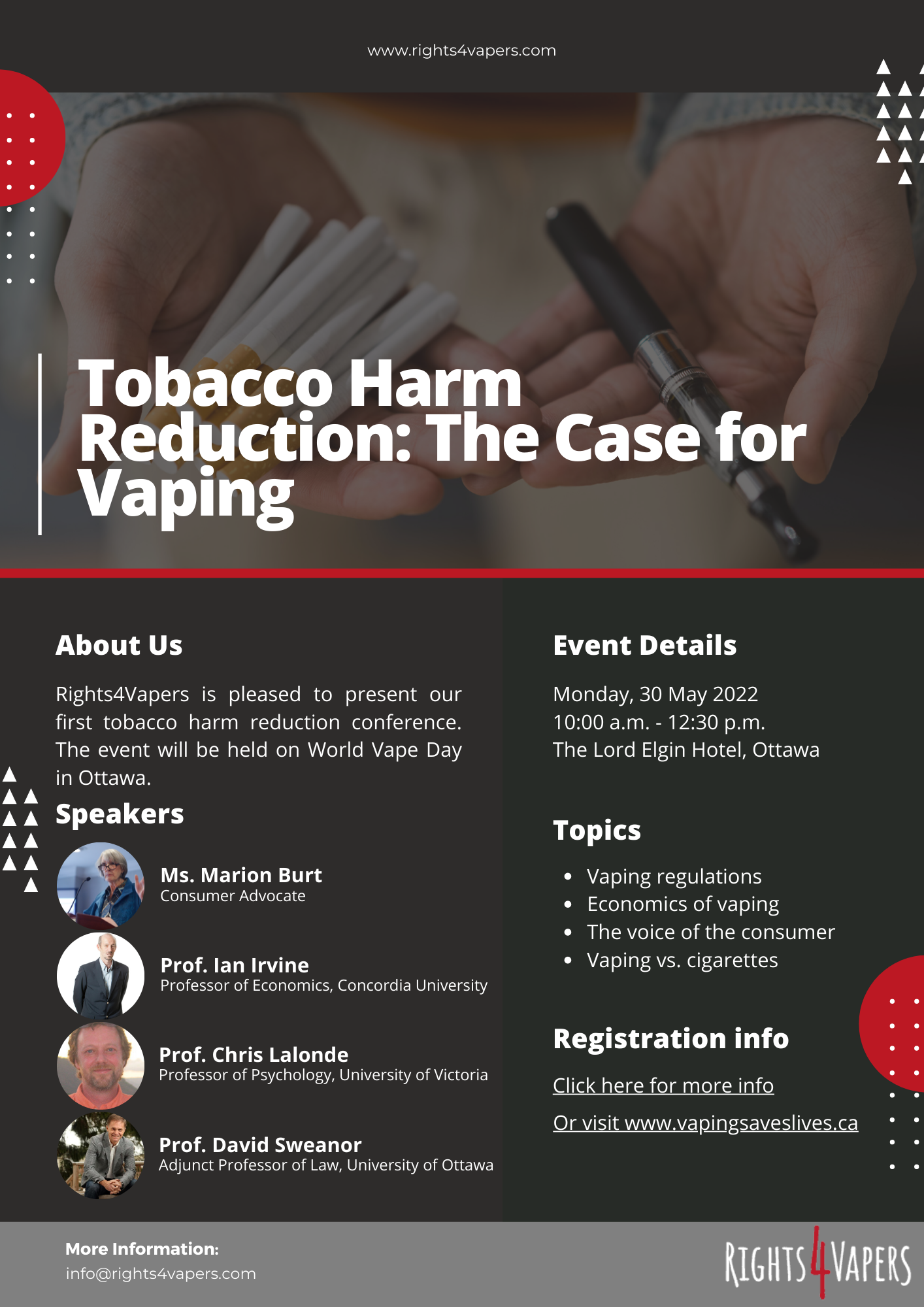National Tobacco Harm Reduction Conference - May 30th in Ottawa
May 30 is World Vape Day.
We want to do something big. We have decided to hold a Tobacco Harm Reduction conference. This is a great opportunity to close out Tobacco Harm Reduction month with a bang!
Speakers:
David Sweanor , Adjunct Professor of Law, University of Ottawa, Chair of the Advisory Board, Centre for Health Law, Policy and Ethics, University of Ottawa
Marion Burt , a vaping consumer and activist.
Chris Lalonde, a psychology professor at the University of Victoria.
Ian Irvine , an economics professor at Concordia University and researcher on tobacco use and the tobacco industry.
RIGHTS4VAPERS LAUNCHES NATIONAL TOBACCO HARM REDUCTION MONTH


48,000 Canadians died in 2021 of tobacco-related illnesses.

About
National Tobacco Harm Reduction Month aims to raise awareness of the importance of tobacco harm reduction and demonstrate how vaping can be a game changing tool in the battle for many to quit smoking.
Every year, over 48,000 Canadians die of smoking related diseases. Zero die of vaping.
Rights4Vapers will be hosting a series of events throughout the month to educate people on why vaping is a forgotten but important element of tobacco harm reduction.
What is Harm Reduction
Harm reduction focuses on helping individuals, in a safe and healthy manner to battle addiction and substance abuse. The harm reduction model centres around providing an individual with the support and the tools that don’t stop them from using a certain substance but instead modify how or what they use to create less harm for themselves.
Harm reduction is accepted in many other areas of life: seatbelts, helmets, etc. But it is less accepted when it comes to smoking. Vaping allows an individual to not have to abstain from nicotine completely, which for many is practically impossible.
Many health organizations around the world acknowledge that vaping is less harmful than smoking. But, here in Canada, we are still implementing draconian regulations that make vaping less available, accessible and affordable to adult smokers looking for an alternative to smoking.
Why is Harm Reduction important?
What is Tobacco Harm Reduction?
Tobacco harm reduction (THR) is a strategy to lower the health risks to individuals and wider society associated with using tobacco products. It is an example of the concept of harm reduction, a strategy for dealing with the use of drugs. Tobacco smoking is widely acknowledged as a leading cause of illness and death, and reducing smoking is vital to public health. In Canada over 48,000 Canadians die each year from tobacco related illness.
Quitting all tobacco products definitively reduces risk the most. However, quitting is difficult, and even approved smoking cessation methods have a low success rate. In addition, some smokers may be unable or unwilling to achieve abstinence. Harm reduction is likely of substantial benefit to these smokers and public health Providing reduced-harm alternatives to smokers is likely to result in lower total population risk than pursuing abstinence-only policies.
Sharable Banners

<a href="https://www.rights4vapers.com/tobacco-harm-reduction-month/" target="_blank" rel="noopener"><img loading="lazy" decoding="async" class="attachment-large size-large" src="https://www.rights4vapers.com/wp-content/uploads/2022/04/tobacco-harm-reduction-banner-1.png" alt="National Tobacco Harm Reduction Month" width="300" height="90" /></a>

<a href="https://www.rights4vapers.com/tobacco-harm-reduction-month/" target="_blank" rel="noopener"><img loading="lazy" decoding="async" class="attachment-large size-large" src="https://www.rights4vapers.com/wp-content/uploads/2022/04/tobacco-harm-reduction-banner-2.png" alt="National Tobacco Harm Reduction Month" width="300" height="90" /></a>

